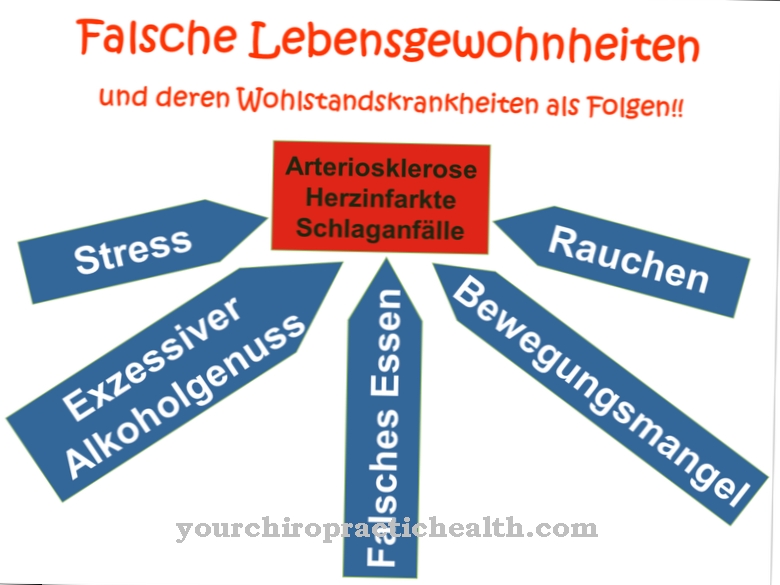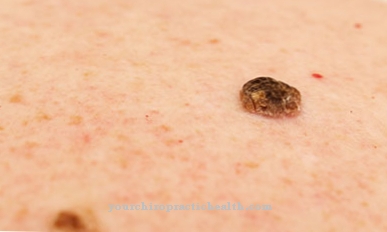Eye injuries can be caused by all sorts of accidents. Since they can have serious consequences, a doctor should be consulted in any case.
What are eye injuries?

© Vladimir - stock.adobe.com
Due to the variety of possible eye injuries, a distinction is made between superficial and perforating eye injuries. All areas of the eye, such as the eyelids, tear ducts, conjunctiva, cornea and retina, eyeball and the optic nerve, can be affected by the injury.
Superficial injuries are mostly bruises, damage to the eyelids and foreign bodies that have penetrated the eye.
Perforating or intraocular eye injuries are to be understood as major damage to the retina or conjunctiva and the vitreous humor. They often require surgery.
causes
The causes of eye injuries can be very different. Foreign objects often get into the eye in accidents in traffic, during work or during leisure time.
Bruises and bruises are mostly caused by the blunt impact of stones, balls, logs, champagne corks or a punch. A fracture of the skull or the nose can also lead to a bruise on the eye.
If the eye injury is caused by contact with acids or bases, it is a chemical burn. Eye injuries due to cuts or stings are mostly caused by splintered glasses or windshields and shattering beverage bottles.
Hot water, fat or vapors, high voltage current, gases or glowing metal lead to burn injuries to the eyes. If the eye was flashed, the eye injury was caused by strong light radiation such as sunlit snow, sunlamps or a welding flame.
Corneal abrasions in the eye can be caused by small twigs, incorrectly inserted contact lenses or fingernails. But surgical interventions on the eye can also be the cause of eye injuries.
You can find your medication here
➔ Medicines for eye infectionsSymptoms, ailments & signs
Eye injuries often occur in combination with more or less severe bleeding, as the skin of the face in particular has a very good blood supply and bleeding therefore occurs even with small and superficial injuries.
Here it is necessary to examine more closely whether the bleeding is actually originating from the eye or whether only a surrounding region is affected. Eye injuries are usually associated with a limitation or complete loss of the [visual disturbance]] and require immediate medical treatment. In the case of blunt bruises, the eye can go into shock and vision temporarily ceases.
This type of injury is usually harmless and regenerates itself after a few hours without permanent damage. If the eye is really injured, severe pain occurs which the patient can hardly bear. Eye injuries without painful side effects are almost unknown.
If the eye is injured, an increased formation of tear fluid can usually be observed. Swelling, redness and bruising can also occur, as well as bleeding directly in the eye, which can be easily seen from the outside. If the eye is injured by a pointed object that penetrates the eye, often nothing can be seen externally.
course
The course of eye injuries can vary greatly depending on the severity and type of injury. Superficial eye injuries can often heal on their own or only require outpatient treatment. But they too can lead to scarring, visual disturbances and corneal opacity and should therefore be examined by a doctor.
Eye injuries in the form of bruises can also be severe. As a result, clouding of the lens, inflammation, retinal detachment, bleeding in the eye or an increase in the internal pressure of the eye can occur. A regular follow-up check must be carried out here due to late effects.
In the case of perforating eye injuries, the disease can easily become serious. These can even lead to blindness. Frequent courses are lens opacities, abscesses, inflammation, damage to the optic nerve and astigmatism.
In rarer cases, particularly serious changes such as strabismus, retinal detachment, glaucoma, forced postures of the head, a change in the vitreous humor, double vision, inflammation of the cornea or conjunctiva or changes in intraocular pressure due to eye injuries can occur.
Complications
Untreated eye injuries can result in corneal opacities and scars. Permanent visual disturbances are also not excluded. Eye bruises can cause eye bleeding, inflammation, clouding of the lens, retinal detachment, and an increase in intraocular pressure. These complications can also appear years later after the actual injury.
If an eye is injured by strong force, the wall of the eyeball can tear. Eyes that have already been operated on or previously damaged eyes are particularly at risk. Intraocular eye injuries can lead to blindness. If the eyeball is affected, it can lead to lens opacities and astigmatism. In addition, the internal pressure can drop.
Carried away germs can cause purulent encapsulation (abscesses) and severe inflammation and damage the optic nerve. Further complications in connection with eye injuries can include malpositions of the eyelids and the eyeballs, double vision, strabismus and increased or decreased intraocular pressure.
The conjunctiva and cornea can become inflamed by the spread of germs. If muscles and nerves are injured, there may be restrictions on eye movements, eyelid closure and pupil openings. The near and far adjustment of the eye can also be restricted.
Injuries such as eye tremors or eye muscle paralysis can cause constrained head postures. Changes in the glass skin can occur and the retina can peel off. The optic nerve can be affected by swelling. A glaucoma can develop.
When should you go to the doctor?
Eye injuries without pain, without impaired vision and without bleeding can first be treated at home, provided that any wounds, for example on the eyelids, can also be cleaned well. Small injuries such as those that occur when children play, for example, should be cleaned and, if necessary, covered with a plaster. Eye injuries of unclear extent, those with pain or bleeding on or in the eye, on the other hand, always require an ophthalmological examination as soon as possible.
An injury to the eyeball is not always recognizable as such for the layman and does not necessarily have to cause immediate pain. Nevertheless, injuries can occur here, which in the worst case threaten the eyesight. In this respect, in the event of an unclear eye injury, a specialist diagnosis is always the safe way to go. Injuries that prevent the affected person from seeing anything on the eye or that bleed profusely are a medical emergency. Here you should call an ambulance immediately or, if necessary, go to a clinic with an ophthalmological department yourself.
Doctors & therapists in your area
Treatment & Therapy
The therapies for an eye injury are as varied as the types of injuries. Superficial foreign bodies are often washed out of the eye by themselves through increased tear fluid. However, they can also be removed by the ophthalmologist by opening the eyelid or using a lancet. Splinters can be removed from the eye by the doctor with a kind of fine drill.
Bruises also heal on their own. However, the healing can be assisted by cool compresses. If the eye shows fine cracks or cuts, these can also heal on their own. It is seldom necessary to sew them. In any case, tears in the conjunctiva must be sewn. If the eye injury is a corneal abrasion, the healing can be supported with special eye ointments that have an antibiotic or disinfectant effect.
If the eyelid has been injured, the tear duct is often damaged as well. It may be necessary to splint it with a silicone tube for three to six months and sew the wound on the lid.
Eye injuries caused by injuries require immediate rinsing of the eye with saline solution or tap water. Perforating eye injuries must be treated surgically. These operations are performed under general anesthesia. Antibiotics should be given to prevent long-term effects.
Outlook & forecast
Eye injuries can be very diverse and different, so that an explicit outlook and prognosis in relation to the course of the disease is very difficult to predict.
Often, eye injuries are caused by a foreign body in the eye. A foreign object in the eye should be removed from the eye as soon as possible, otherwise there is a risk of infection. Bacteria and viruses can attack the eye, which can lead to pus formation. The foreign body itself can also cause damage to the connective tissue and the cornea, so that a medical examination is urgently required.
If treatment by a doctor is dispensed with at this point, the prospect of self-healing looks less positive. The infection will increase significantly in such a case and there will be strong reddening in the eye. Permanent consequential damage is possible if the foreign body remains in the eye.
Anyone who would like to positively influence the prospect of smooth healing should seek medical treatment as soon as possible. A high level of cleanliness and hygiene also play a very important role, as this prevents bacteria and viruses from multiplying.
You can find your medication here
➔ Medicines for eye infectionsprevention
Eye injuries can be prevented by wearing suitable protective and quality sunglasses and observing important accident prevention regulations. Also, you should never look directly into the sun or onto sunlit snow to avoid eye injuries.
Aftercare
Eye injuries can occur in many different degrees of severity, so that a corresponding follow-up examination does not always have to take place. If there is only an inflammation of the conjunctiva, the person concerned can safely dispense with further examinations. In such a case, consequential damage or complications should not arise.
However, the situation is different if there is a serious eye injury. If the eye injury occurs as a result of strong external violence, it is of course imperative to see an appropriate doctor. Appropriate treatment or even an operation cannot be avoided. Especially if the retina or the conjunctiva have been injured, there is an acute risk of permanent loss of eyesight.
Regular follow-up examinations should take place throughout the healing process. This allows possible complications to be identified early and nipped in the bud. In many cases, inflammation also occurs if there was an open wound beforehand. If you decide to have regular follow-up examinations, you can count on a much more pleasant course of the disease.
The eyes are a very sensitive and important organ at the same time. Thus, eye injury should not be taken lightly. Immediate visits to the doctor and subsequent check-ups are extremely important to ensure a full and speedy recovery.
You can do that yourself
In the event of an eye injury, it is not always necessary to consult a doctor. Slight injuries such as a black eye, swelling from foreign bodies or an inflammation can be cured independently with a few home remedies and measures.
It is usually sufficient to remove any foreign bodies (e.g. splinters or insects) from the eye and then disinfect and cool the affected area. For superficial bruises, cooling applications such as cold compresses, ice spray or ice packs are also recommended. The swelling can also be treated with decongestants such as eucalyptus, mint or garlic. Tinctures and ointments made from arnica and marigold ointment have also proven effective.
Superficial cuts and corneal abrasions usually heal on their own. Recovery can be accelerated by using antibiotic disinfecting eye ointments and various home remedies (aloe vera, valerian or honey). At the same time, the head should be raised so that the accumulated fluid around the eye area can drain away.The affected eye should be temporarily protected from excessive exposure to light, cold and other stimuli. Rest and relaxation also contribute to a quick and complication-free recovery in the event of eye injuries.
























.jpg)



